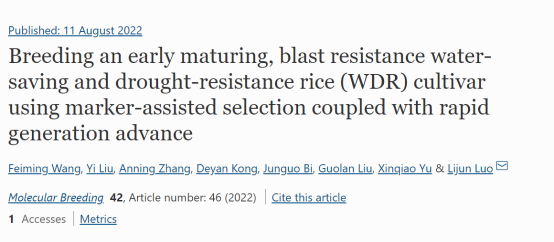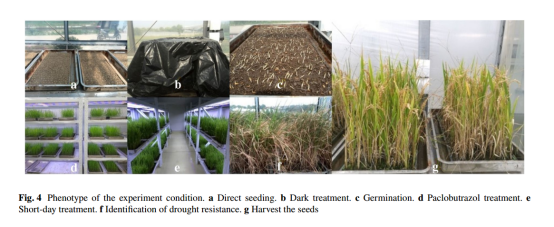Breeding an Early Maturing, Blast Resistance Water-saving and Drought-resistance Rice (WDR) Cultivar Using Marker-assisted Selection Coupled with Rapid Generation Advance

The japonica water-saving and drought resistance rice (Oryza sativa L.) (WDR) cultivar Huhan 9 harbors genes for resistance to rice blast (Magnaporthe oryzae), including Pi-ta and Pi-b. The early maturing japonica rice cultivar Suhuxiangjing and the high-yield WDR cultivars Huhan 3 and Huhan 11 were used as the parents to conduct single cross breeding and composite hybridization breeding. Strict drought resistance screening was conducted in the segregating generations, the genotypes of which were determined using functional markers of Pi-ta and Pi-b genes. By combining the rapid generation advance of the industrialized breeding system and multi-site shuttle identification, the new WDR cultivar Huhan 106 with early maturity, blast resistance, high yield, and high quality was bred, and it was certified by the Agricultural Crop Variety Certification Commission of Shanghai in 2020. Molecular marker-assisted selection coupled with rapid generation advance and multi-site shuttle identification is a rapid and efficient breeding method for the valueadded improvement of crop varieties.
The research team took the cultivation of the new variety "Huhan 106" approved by the Agricultural Crop Variety Certification Commission of Shanghai as a case, and systematically introduced the method of using molecular markers and the industrialized breeding system to rapidly add generation to select new varieties of disease resistant, high-quality, water-saving and drought resistant rice. The results showed that using molecular marker assisted selection and rapid generation technology can efficiently and accurately aggregate multiple pairs of disease resistance genes, and provide a fast and efficient breeding method for the breeding of water-saving and drought resistant rice varieties.
In this study, in order to rapidly breed a new WDR cultivar with early maturity and blast resistance, the molecular markers of the rice blast resistance genes Pi-ta and Pi-b were used to conduct gene pyramiding in segregating generation materials. In combination with RGA technology and multi-site shuttle identification of traits, the new WDR cultivar Huhan 106 with high quality, high yield, blast resistance, and early maturity was bred. Our results suggest that the pyramiding of favorable traits and the value-added improvement of varieties can be quickly and efficiently achieved by the combined use of MAS and RGA.In this study, cross breeding was started in 2009, and the cultivar name Huhan 106 was officially approved in 2014, which was a period 5 years. In 2020, this line was approved as a new cultivar by the Agricultural Crop Variety Certification Commission of Shanghai (No. 2020011). This process took 2–3 fewer years than traditional rice breeding, realizing the rapid, directional, and efficient cultivation of new cultivars. Our results showed that new WDR cultivars can be quickly and effectively generated using the method of RGA and MAS combined with the multi-site shuttle screening of traits.
The future developmental goal of rapid breeding is to advance breeding cycles four to five generations every year. This faster and more effective method of reducing breeding cycles will contribute to rice genome research and breeding.


用户登录